Baku Fortress Wall
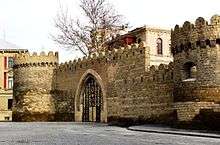
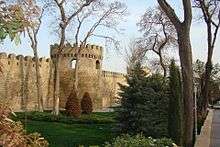
Baku Fortress (Azerbaijani: Bakı Qalası) is the largest of Absheron fortresses. The fortress consists of the Icheri Sheher and the walls and towers surrounding it, and was included by UNESCO into the World Cultural Heritage List in 2000. It was built in about 1138-1139 on the order of the Shirvanshah Manuchohr III (1120-1149).[1]
Based on traveler's illustrations and photos of the 19th century, the fortress consisted of a double wall. The first wall was built by the Shirvanshah III Manuchohr, and the second wall was built during the time of Shirvanshah Akhsitan I.[2]
However, the second fortress walls were destroyed during the reign of Russia in Azerbaijan. The first fortress wall still remains. Baku Fortress has two gates. One of them opened to the Caspian Sea and the other to land.[3] The city walls, which had a height of 8–12 meters and a width of 3.5 meters, provided for Baku's security. In the Middle Ages, the fortress walls were 1500 meters long and now the walls are 500 meters long.[4] In the northern part of the fortress there is a main tower - quadrangular castle. This fortress is called "armory" in the nation's etiology. The peculiarity of armory is that, despite being a defensive unit, builders have strengthened the wall by raising it in the center of the fortress wall, not in the center of the city.[5]
 | ||
| "Baku fortress of the XII century stone inscription, in line with the Kufic Arabic language is written the words: "City Tower building was ordered by magnificent melik, scientist, fair, triumphant, prosaic, mujahid (fighter), and the state of religion, the stronghold of Islam and Muslims, the largest Khagan, the Shirvanshah Abulhija Manouchehr bin". Found in 1954. Museum of History of Azerbaijan..." .[6] |
Baku, in fact, Icheri Sheher was the capital of Shirvanshahs state several times. For the first time, this incident took place in 1191 when Shirvanshah Akhsitan I moved here with her palace after the terrible earthquake in Shamakhi. Akhsitan I paid special attention to the construction of cities and castles. As a result of his efforts, the complex structure of defense structures in the Absheron peninsula was strengthened, and Baku strongly consolidated it. All this played a crucial role in the attack of Russian Navy Bandits in Baku. The Russians were defeated and their ships were destroyed. The second time Baku became the capital city during the reign of Shirvanshah I Ibrahim. In 1608-1609, Baku judge Zulfugar Khan constructed the second line of 10-12 meters from the old fortifications.[7]
According to some historians, the ditch was filled with seawater between the walls. But in practice this type of foreses is unknown. This inter-walls space was usually used for emergency deployment of troops during the siege. The trench was dug in front of the wall and between the walls could be a dense trench filled with combustion. It was a safe shelter for the harbor and the ships entering here.[8]
At the beginning of the twentieth century, the military governor of Baku in 1868 applied to the Caucasus Military Department for the demolition of the fortress in order to renovate the city as a military defensive fortification. In 1870, the second wall of the castle was demolished.[9]
The issue was raised again at the Summit in 1886 and it was decided that the door of the "Zulfugar Khan Gate" on the wall of the second castle was to be built next to the Shah Abbas gate, which was on the wall of the first fortress.[10]
There is also a mythical defender of Baku fortress. According to the legend spread among people giant bull's positive aura protected the fortress. The bull was defended by two big lions. The Baku fortress has witnessed many historical events and defended the Shirvanshah state and the capital of the Baku khanate for a long time.[11]
Baku Fortress Wall in art
Icheri Sheher is depicted in the works of many artists. Monuments and streets of the ancient city can be seen in the works of Engelbert Kaempfer, Aleksey Bogolyubov, Grigory Gagarin, Vasily Vereshchagin, Aleksandr Kuprin, Azim Azimzade, Tahir Salahov and other famous artists.[12]
It is believed that Engelbert Kaempfer, Swedish artist, who first described Baku, created his appearance in 1630.[13]
The general plan of Icheri Sheher is reflected on the opposite side of the Azerbaijani banknote of 10 manat.[14]
- In Art Works
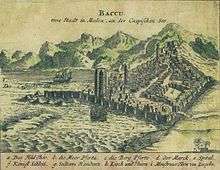 Engelbert Kaempfer - Baku, year of 1630
Engelbert Kaempfer - Baku, year of 1630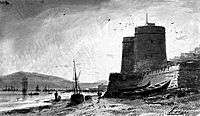 A.Bogolyubov - Baku, 1861
A.Bogolyubov - Baku, 1861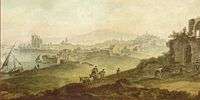 Q. Sergeyev - Baku, 1796
Q. Sergeyev - Baku, 1796 Jan Pyer Mone - Baku, 1830
Jan Pyer Mone - Baku, 1830 Pyotr Vereşşagin. «Baku view from the sea». 1872
Pyotr Vereşşagin. «Baku view from the sea». 1872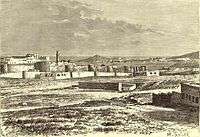 T. Teylor - Baku port və Bayıl, 1880-1881
T. Teylor - Baku port və Bayıl, 1880-1881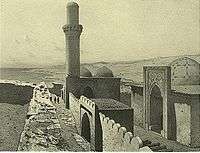 Grigory Gagarin - Khan Palace in Baku, 1847
Grigory Gagarin - Khan Palace in Baku, 1847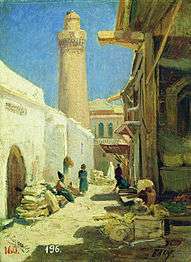 Aleksey Boqolyubov - Afternoon in Baku street, 1861
Aleksey Boqolyubov - Afternoon in Baku street, 1861
See also
References
- ↑ "The 10 things you must absolutely do in Baku". The Independent. 2017-05-11. Retrieved 2017-05-17.
- ↑ Walled City of Baku with the Shirvanshah's Palace and Maiden Tower
- ↑ Walled City of Baku with the Shirvanshah's Palace and Maiden Tower
- ↑ Walled City of Baku with the Shirvanshah's Palace and Maiden Tower
- ↑ "The 10 things you must absolutely do in Baku". The Independent. 2017-05-11. Retrieved 2017-05-17.
- ↑ Ашурбейли 1992.
- ↑ Old City site
- ↑ "The 10 things you must absolutely do in Baku". The Independent. 2017-05-11. Retrieved 2017-05-17.
- ↑ Old City site
- ↑ "The 10 things you must absolutely do in Baku". The Independent. 2017-05-11. Retrieved 2017-05-17.
- ↑ Walled City of Baku with the Shirvanshah's Palace and Maiden Tower
- ↑ Old City site
- ↑ Old City site
- ↑ Old City site
| Wikimedia Commons has media related to Fortress of Baku. |